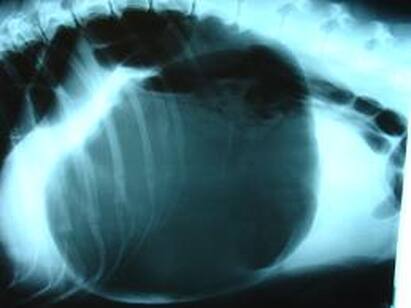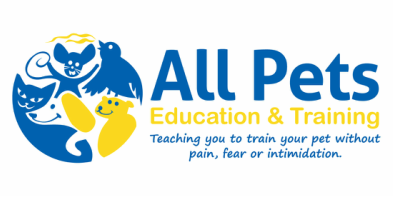Bloat & GDV
Gastric Dilation Volvulus
 http://en.wikipedia.org/wiki/Gastric_dilatation_volvulus
http://en.wikipedia.org/wiki/Gastric_dilatation_volvulus
Canine Bloat and Gastric Dilation Volvulus.
This condition can be seen in any dog (rarely cats), but most commonly affects deep-chested breeds of dogs including Greyhounds, Great Danes, German shepherds, St Bernards, Weimaraners and Dobermans.
“Dogs that weigh more than 45 kg have an approximate risk of 20% for developing bloat at some point in their lifetime.” (ACEVets, 2014)
What is Bloat & GDV?
Gastric dilation and volvulus (GDV) is a life-threatening condition, which causes the animal to die a painful death within just a few hours of its occurrence.
The classic history for these cases is that the animal has been fed (either deliberately or the animal has broken into a food bag/container), often on dry foods, and then exercised. The patient becomes depressed and as time progresses the abdominal swelling becomes more obvious.
Bloat is a condition many have heard of. It is a condition in which the stomach becomes painfully distended by gas or food (this is the dilation). Unfortunately the bloated stomach has a tendency to twist or flip. When this occurs there is no way for the food or gas to exit (above or below). The blood supply to the stomach is compromised and this in turn can cause death and necrosis to part or all of the stomach. This is one of the major complications of GDV.
If the stomach has twisted, blood supply to the spleen can also be affected, and sometimes a splenectomy is required.
The damage caused to the stomach and/or spleen can cause a heart arrhythmia (abnormal heart beat). This can affect the hearts ability to pump blood to the body. The patient will often go into shock.
Factors increasing the risk of bloat
What can you do to reduce the chance of bloat?
What are the signs of Bloat or GDV?
What do I do if I think my dog has bloat/GDV?
How is Bloat/GDV diagnosed and treated?
Prognosis for patients with GDV?
Patients with GDV that are recognized and treated early have a good chance of survival - approximately 75%. (Henriques, 2020)
GDV without treatment is always fatal (this is a painful and distressing death).
References
Aecvets.com.au. 2014. Pet Health - Information Sheets. [online] Available at: <http://www.aecvets.com.au/Pet-Health/Information-sheets.aspx> [Accessed 20 Apr. 2014].
Aspinall, V., 2006.The complete textbook of veterinary nursing. 1st ed. Edinburgh; Butterworth Heinemann Elsevier
Avmajournals.avma.org. 2000. Non-Dietary Risk Factors For Gastric Dilatation-Volvulus In Large And Giant Breed Dogs | Journal Of The American Veterinary Medical Association | Vol 217 , No 10. [online] Available at: <https://avmajournals.avma.org/doi/abs/10.2460/javma.2000.217.1492> [Accessed 14 July 2020].
Battaglia, A., 2001. Small animal emergency and critical care. 1st ed. Philadelphia: W.B. Saunders.
Cooper, B., Turner, L. and Mullineaux, E., 2011. The BSAVA textbook of veterinary nursing. 1st ed. Gloucester [England]: British Small Animal Veterinary Association.
Henriques, J., 2020. Preventing Bloat In Dogs With These Top DIY Remedies | Dogs Naturally. [online] Dogs Naturally. Available at: <https://www.dogsnaturallymagazine.com/preventing-bloat-in-dogs-naturally/> [Accessed 14 July 2020].
This condition can be seen in any dog (rarely cats), but most commonly affects deep-chested breeds of dogs including Greyhounds, Great Danes, German shepherds, St Bernards, Weimaraners and Dobermans.
“Dogs that weigh more than 45 kg have an approximate risk of 20% for developing bloat at some point in their lifetime.” (ACEVets, 2014)
What is Bloat & GDV?
Gastric dilation and volvulus (GDV) is a life-threatening condition, which causes the animal to die a painful death within just a few hours of its occurrence.
The classic history for these cases is that the animal has been fed (either deliberately or the animal has broken into a food bag/container), often on dry foods, and then exercised. The patient becomes depressed and as time progresses the abdominal swelling becomes more obvious.
Bloat is a condition many have heard of. It is a condition in which the stomach becomes painfully distended by gas or food (this is the dilation). Unfortunately the bloated stomach has a tendency to twist or flip. When this occurs there is no way for the food or gas to exit (above or below). The blood supply to the stomach is compromised and this in turn can cause death and necrosis to part or all of the stomach. This is one of the major complications of GDV.
If the stomach has twisted, blood supply to the spleen can also be affected, and sometimes a splenectomy is required.
The damage caused to the stomach and/or spleen can cause a heart arrhythmia (abnormal heart beat). This can affect the hearts ability to pump blood to the body. The patient will often go into shock.
Factors increasing the risk of bloat
- Deep chested dog, weighing more than 45kg
- Feeding only one meal a day
- Feeding Dry foods vs Wet or Raw foods
- Feeding from an elevated bowl
- Exercise immediately before or after feeding
- Gulping of food or large amounts of water
What can you do to reduce the chance of bloat?
- Consider what you feed
- RAW diets are often considered best - as diets such as dry foods contain unnecessary carbohydrates and starches
- Dry diets with citric acid increase the risk by 320% (Henriques, 2020)
- Diets with fat and rendered meat meal and bone in the top 4 ingredients increase risk by 223% (Henriques, 2020)
- If choosing to feed dry food, minimise how much water your dog drinks directly after eating.
- Consider how you feed
- Avoid using raised or elevated food bowls
- Use slow feeders that prevent gulping/scoffing of food
- examples would include slow feed bowls, kongs and similar food dispensing toys
- In a 2000 study with the AVMA they found that 20% of cases in large breed dogs, and 52% of cases in giant breed dogs related directly to using a raised food bowl
- Frequency of feeding
- Feeding smaller meals more frequently will reduce the chance of bloating
- Manage exercise carefully
- When exercising (walks, runs, tug etc)- do not do so directly before or after a meal. Allow your dog time to "rest and digest".
What are the signs of Bloat or GDV?
- Swollen abdomen (this doesn’t always occur)
- Salivation
- Hanging head low
- Vomiting
- Non-productive retching/gagging
- Anxiety
- Restlessness/pacing
- Depression
- Flank watching
What do I do if I think my dog has bloat/GDV?
- Immediately take your dog to a veterinarian
- If it occurs overnight, and your regular vet is not open, do not delay – take your dog to an Emergency Afterhours Vet Clinic
How is Bloat/GDV diagnosed and treated?
- Your veterinarian will take a history and examine your pet
- Your pet will be given pain relief
- On X-ray your vet will be able to see a large dilated stomach
- Your vet may attempt to pass a stomach tube to relieve the pressure in your pet’s stomach.
- If they are unable to pass the stomach tube (the stomach has twisted), your vet may need to relieve the pressure in your pets stomach using a needle and placing it into the stomach directly from the flank behind your pets ribs.
- Once the stomach is relieved of pressure, treat for shock and supply intravenous fluids
- ECG monitoring of your pets heart for cardiac arrhythmias
- Unfortunately a true GDV (bloat with stomach twist) requires either surgery or euthanasia
- Cases of bloat without stomach twist (Gastric dilation), may still require surgery to empty the stomach contents and perform a procedure to ensure that the stomach is unable to twist.
- If the stomach has twisted, surgery to untwist it and tack (place a suture) the stomach to the abdomen wall to prevent future rotation will be required.
- Depending on severity, part of the stomach may need to be removed, and the spleen if it has been damaged will also be removed (splenectomy).
- Your Veterinarian will guide you and help you make an informed decision.
Prognosis for patients with GDV?
Patients with GDV that are recognized and treated early have a good chance of survival - approximately 75%. (Henriques, 2020)
GDV without treatment is always fatal (this is a painful and distressing death).
References
Aecvets.com.au. 2014. Pet Health - Information Sheets. [online] Available at: <http://www.aecvets.com.au/Pet-Health/Information-sheets.aspx> [Accessed 20 Apr. 2014].
Aspinall, V., 2006.The complete textbook of veterinary nursing. 1st ed. Edinburgh; Butterworth Heinemann Elsevier
Avmajournals.avma.org. 2000. Non-Dietary Risk Factors For Gastric Dilatation-Volvulus In Large And Giant Breed Dogs | Journal Of The American Veterinary Medical Association | Vol 217 , No 10. [online] Available at: <https://avmajournals.avma.org/doi/abs/10.2460/javma.2000.217.1492> [Accessed 14 July 2020].
Battaglia, A., 2001. Small animal emergency and critical care. 1st ed. Philadelphia: W.B. Saunders.
Cooper, B., Turner, L. and Mullineaux, E., 2011. The BSAVA textbook of veterinary nursing. 1st ed. Gloucester [England]: British Small Animal Veterinary Association.
Henriques, J., 2020. Preventing Bloat In Dogs With These Top DIY Remedies | Dogs Naturally. [online] Dogs Naturally. Available at: <https://www.dogsnaturallymagazine.com/preventing-bloat-in-dogs-naturally/> [Accessed 14 July 2020].
